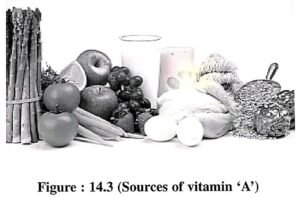Vitamin ‘A’ – Functions, Food Sources, Deficiencies and Toxicity
Vitamin ‘A’
- vitamin A is a fat-soluble vitamin. Vitamin A is present only in animal-based food products. In plantbased food products, carotenoids are present which get converted into vitamin A in the body. Carotenoids are thus also known as pro-vitamin A.
Types of vitamin ‘A’
Vitamin A is mainly of 4 types. In some food items more than 1 type of vitamin A is present.
- Vitamin A (Retinol) — it is also called as Retinol. It is present only in animal-based food products.
- Vitamin A aldehyde— it is also called Retinal. It is present in the Rhodopsin and Todopsin pigment of rods and cones in the retina of eyes. This vitamin is helpful in providing eye sight.
- Vitamin A, retinoic acid— it is produced in the body and is essential for the physical growth and development.
- Vitamin A2 — it is present in the liver of freshwater fish. It is a less-active vitamin.
B carotene— it is found in plant- based food sources. It is granulated and dark-red in color. It is very important and useful for health of the body. This gets converted into vitamin ‘A’ in the body.
Functions of vitamin ‘A’—
- Providing normal eyesight to the eyes — vitamin A is essential for the health of eyes. There are two types of cells present in the retina of eye. Rods and cones help in seeing in dim and bright light and also in identifying dyes. Color-providing pigments are also present in these rods and cones. Rhodopsin pigment is present in rods and Todopsin in cones. A protein called Opsin is present in them. Vitamin A aldehyde combines with Opsin protein and changes into Rhodopsin which is also known as “Visual Purple’. In the presence of light, Rhodopsin gets converted back into vitamin A aldehyde and Opsin. In this way, formation of Rhodopsin takes place in dim light and iodopsin in bright light. This cycle goes on uninterrupted. Thus, the ability of eyes to see in light depends on vitamin ‘A’.
- For the health of epithelium tissues— Vitamin A is helpful in maintaining activity and stability of epithelium tissues. All the external and internal organs of our body are covered with this epithelium tissue. This tissue secretes mucous and protects the organs from bacteria, viruses and germs. Vitamin A helps in this secretion and thus helps in keeping skin and organs soft, moist and gentle.
- Physical growth and development— Vitamin A plays an important role in physical growth and development. Many researchers have proved that in the absence of vitamin A, cell division process is reduced by 30%. Therefore vitamin A helps in physical growth and development.
- Helpful in maintaining health of reproductive organs— Vitamin A plays an important role in maintaining health and activity of reproductive organs. Deficiency of vitamin A leads to low secretion of sexual hormones. As a result disorders develop in male and female reproductive organs.
- Helpful in growth of bones— Vitamin A is essential for normal growth and development of bones.
- Resistant to infections— Vitamin A resists infections in the body. it provides strength to epithelium tissues as a result infection does not occur immediately.
- Maintaining health of nervous system— Vitamin A is essential for activity of tissues of nervous system. In the absence of this myelin sheath gets destroyed and disorders develop in nervous system.
- Synthesis of glycoprotein— Vitamin A plays an invaluable role in the synthesis of Glycoprotein. In the absence of this vitamin, chances of stones in liver and kidneys increase.
- Maintaining health of white blood cells— Vitamin A is essential for maintaining health of white blood cells. In the absence of vitamin A number of WBCs reduces or Leucopenia oceurs.
- Synthesis of protein— Vitamin A helps in synthesis of protein. In the absence of vitamin A metabolism of Ribonucleic acid does not take place properly. Consequently activity of protein is affected.
Effects of deficiency of Vitamin A—
1. Night-blindness— deficiency of vitamin A causes night blindness. It is a condition making it difficult or impossible to see in relatively low light, especially when the patient walks from light to darkness or from bright sunlight to a room.

2. Xerophthalmia— It is abnormal dryness of the conjunctiva and cornea of the eye, with inflammation and ridge formation, typically associated with vitamin A deficiency. This is mainly due to keratinization of cornea because of which the internal part of cornea appears as smoky cloud. Over a period eyes lose their sight.
3. Bitot’s spots— Bitot’s spots are the buildup of keratin located superficially in the conjunctiva, which are oval, triangular or irregular in shape
4. Xerosis conjunctivae— Deficency of Vitamin causes conjunctiva to grow thick and dry. Sometimes it gets wrinkles or other injury.
5. Xerosis cornea— It is the dryness of the cornea because of lack of tears.
6. Keratomalacia—It is an eye disorder that results from vitamin A deficiency. In this disorder, cornea becomes soft, injured and infected with bacteria. The resulting cornea becomes totally opaque, which is one of the most common reasons for blindness.
7. Phrynoderma— Due to deficiency of vitamin A sweat glands do not work properly and so sweat is not formed and skin turns dry, rough and hard.
8. Interrupted physical growth— If the deficiency of vitamin A prolongs growth and development of bones does not take place properly.
9. Decreased reproductive activity— Vitamin A deficiency affects male reproductive organs. Hormone secretion lessens and less sperms are formed.
Effect of over-availability of vitamin A—
Over availability of vitamin is harmful as much as deficiency of vitamin A. Over-availability of vitamin is known as hypervitaminosis. Effects of excess of vitamin A
- Loss of appetite
- Joint pain
- Bleeding in retina of eye
- Liver enlargement
- Swelling in bones of legs
- Headache and irritation
- Difficulty in breathing
- Hair loss
- Blisters and pimples on lips
Treatment of deficiency of vitamin A—
- If there is deficiency of vitamin A then 10,000 g of vitamin A should be given for 10 days. If there is over-deficiency then 50,000 pg of vitamin A should be given for a few weeks.
Sources of vitamin A—
- Vitamin A is mainly present in liver oil of fish. Other sources are— fish oil, liver, eggs, butter, milk, etc. plant based sources are— leaves of Amaranth, coriander leaves, carrots, drumstick leaves, mint leaves, spinach, etc. are sources of 3 carotene.

Home Science Latest Post :- Click Here
Vitamins Questions and Answers :-
Que1. Which of the given was invented by Kazimierz Funk?
(a) Enzymes
(b) Hormones
(c) Vitamins
(d) Proteins
Click to show/hide
Que2. What type of compounds are Vitamins?
(a) Organic Compound
(b) Inorganic Compound
(c) Living Organisms
(d) None of the above
Click to show/hide
Que3. Which is also known as the “Accessory dietary factor”?
(a) Fats
(b) Vitamins
(c) Proteins
(d) Hormones
Click to show/hide
Que4. Which is not an essential element for plant growth?
(a) Potassium
(b) Calcium
(c) Magnesium
(d) Sodium
Click to show/hide
Que5. Which of the given has the highest calorie value per unit?
(a) Vitamins
(b) Proteins
(c) Fats
(d) Carbohydrates
Ans. ⇒ ????
